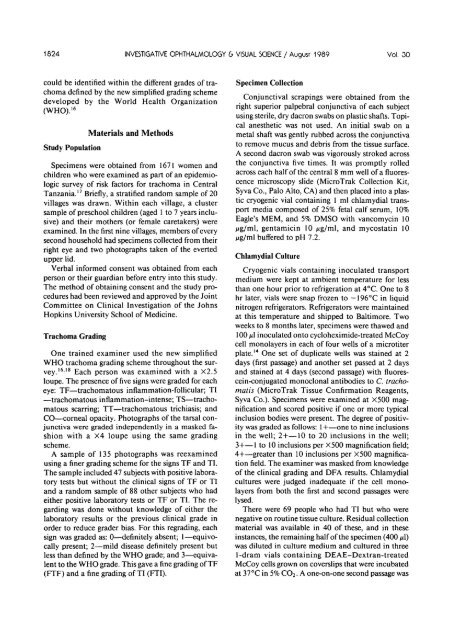The Epidemiology of Infection in Trachoma - Investigative ...
The Epidemiology of Infection in Trachoma - Investigative ...
The Epidemiology of Infection in Trachoma - Investigative ...
You also want an ePaper? Increase the reach of your titles
YUMPU automatically turns print PDFs into web optimized ePapers that Google loves.
1824 INVESTIGATIVE OPHTHALMOLOGY & VISUAL SCIENCE / August 1989 Vol. 30<br />
could be identified with<strong>in</strong> the different grades <strong>of</strong> trachoma<br />
def<strong>in</strong>ed by the new simplified grad<strong>in</strong>g scheme<br />
developed by the World Health Organization<br />
(WHO). 16<br />
Study Population<br />
Materials and Methods<br />
Specimens were obta<strong>in</strong>ed from 1671 women and<br />
children who were exam<strong>in</strong>ed as part <strong>of</strong> an epidemiologic<br />
survey <strong>of</strong> risk factors for trachoma <strong>in</strong> Central<br />
Tanzania. 17 Briefly, a stratified random sample <strong>of</strong> 20<br />
villages was drawn. With<strong>in</strong> each village, a cluster<br />
sample <strong>of</strong> preschool children (aged 1 to 7 years <strong>in</strong>clusive)<br />
and their mothers (or female caretakers) were<br />
exam<strong>in</strong>ed. In the first n<strong>in</strong>e villages, members <strong>of</strong> every<br />
second household had specimens collected from their<br />
right eye and two photographs taken <strong>of</strong> the everted<br />
upper lid.<br />
Verbal <strong>in</strong>formed consent was obta<strong>in</strong>ed from each<br />
person or their guardian before entry <strong>in</strong>to this study.<br />
<strong>The</strong> method <strong>of</strong> obta<strong>in</strong><strong>in</strong>g consent and the study procedures<br />
had been reviewed and approved by the Jo<strong>in</strong>t<br />
Committee on Cl<strong>in</strong>ical Investigation <strong>of</strong> the Johns<br />
Hopk<strong>in</strong>s University School <strong>of</strong> Medic<strong>in</strong>e.<br />
<strong>Trachoma</strong> Grad<strong>in</strong>g<br />
One tra<strong>in</strong>ed exam<strong>in</strong>er used the new simplified<br />
WHO trachoma grad<strong>in</strong>g scheme throughout the survey.<br />
1618 Each person was exam<strong>in</strong>ed with a X2.5<br />
loupe. <strong>The</strong> presence <strong>of</strong> fivesigns were graded for each<br />
eye: TF—trachomatous <strong>in</strong>flammation-follicular; TI<br />
—trachomatous <strong>in</strong>flammation-<strong>in</strong>tense; TS—trachomatous<br />
scarr<strong>in</strong>g; TT—trachomatous trichiasis; and<br />
CO—corneal opacity. Photographs <strong>of</strong> the tarsal conjunctiva<br />
were graded <strong>in</strong>dependently <strong>in</strong> a masked fashion<br />
with a X4 loupe us<strong>in</strong>g the same grad<strong>in</strong>g<br />
scheme.<br />
A sample <strong>of</strong> 135 photographs was reexam<strong>in</strong>ed<br />
us<strong>in</strong>g a f<strong>in</strong>er grad<strong>in</strong>g scheme for the signs TF and TI.<br />
<strong>The</strong> sample <strong>in</strong>cluded 47 subjects with positive laboratory<br />
tests but without the cl<strong>in</strong>ical signs <strong>of</strong> TF or TI<br />
and a random sample <strong>of</strong> 88 other subjects who had<br />
either positive laboratory tests or TF or TI. <strong>The</strong> regard<strong>in</strong>g<br />
was done without knowledge <strong>of</strong> either the<br />
laboratory results or the previous cl<strong>in</strong>ical grade <strong>in</strong><br />
order to reduce grader bias. For this regrad<strong>in</strong>g, each<br />
sign was graded as: 0—def<strong>in</strong>itely absent; 1—equivocally<br />
present; 2—mild disease def<strong>in</strong>itely present but<br />
less than def<strong>in</strong>ed by the WHO grade; and 3—equivalent<br />
to the WHO grade. This gave a f<strong>in</strong>egrad<strong>in</strong>g <strong>of</strong> TF<br />
(FTF) and a f<strong>in</strong>e grad<strong>in</strong>g <strong>of</strong> TI (FTI).<br />
Specimen Collection<br />
Conjunctival scrap<strong>in</strong>gs were obta<strong>in</strong>ed from the<br />
right superior palpebral conjunctiva <strong>of</strong> each subject<br />
us<strong>in</strong>g sterile, dry dacron swabs on plastic shafts. Topical<br />
anesthetic was not used. An <strong>in</strong>itial swab on a<br />
metal shaft was gently rubbed across the conjunctiva<br />
to remove mucus and debris from the tissue surface.<br />
A second dacron swab was vigorously stroked across<br />
the conjunctiva five times. It was promptly rolled<br />
across each half <strong>of</strong> the central 8 mm well <strong>of</strong> a fluorescence<br />
microscopy slide (MicroTrak Collection Kit,<br />
Syva Co., Palo Alto, CA) and then placed <strong>in</strong>to a plastic<br />
cryogenic vial conta<strong>in</strong><strong>in</strong>g 1 ml chlamydial transport<br />
media composed <strong>of</strong> 25% fetal calf serum, 10%<br />
Eagle's MEM, and 5% DMSO with vancomyc<strong>in</strong> 10<br />
Mg/ml, gentamic<strong>in</strong> 10 ng/m\, and mycostat<strong>in</strong> 10<br />
buffered to pH 7.2.<br />
Chlamydial Culture<br />
Cryogenic vials conta<strong>in</strong><strong>in</strong>g <strong>in</strong>oculated transport<br />
medium were kept at ambient temperature for less<br />
than one hour prior to refrigeration at 4°C. One to 8<br />
hr later, vials were snap frozen to -196°C <strong>in</strong> liquid<br />
nitrogen refrigerators. Refrigerators were ma<strong>in</strong>ta<strong>in</strong>ed<br />
at this temperature and shipped to Baltimore. Two<br />
weeks to 8 months later, specimens were thawed and<br />
100 Ail <strong>in</strong>oculated onto cycloheximide-treated McCoy<br />
cell monolayers <strong>in</strong> each <strong>of</strong> four wells <strong>of</strong> a microtiter<br />
plate. 14 One set <strong>of</strong> duplicate wells was sta<strong>in</strong>ed at 2<br />
days (first passage) and another set passed at 2 days<br />
and sta<strong>in</strong>ed at 4 days (second passage) with fluoresce<strong>in</strong>-conjugated<br />
monoclonal antibodies to C. trachomatis<br />
(MicroTrak Tissue Confirmation Reagents,<br />
Syva Co.). Specimens were exam<strong>in</strong>ed at X500 magnification<br />
and scored positive if one or more typical<br />
<strong>in</strong>clusion bodies were present. <strong>The</strong> degree <strong>of</strong> positivity<br />
was graded as follows: 1 +—one to n<strong>in</strong>e <strong>in</strong>clusions<br />
<strong>in</strong> the well; 2+—10 to 20 <strong>in</strong>clusions <strong>in</strong> the well;<br />
3+—1 to 10 <strong>in</strong>clusions per X500 magnification field;<br />
4+—greater than 10 <strong>in</strong>clusions per X500 magnification<br />
field. <strong>The</strong> exam<strong>in</strong>er was masked from knowledge<br />
<strong>of</strong> the cl<strong>in</strong>ical grad<strong>in</strong>g and DFA results. Chlamydial<br />
cultures were judged <strong>in</strong>adequate if the cell monolayers<br />
from both the first and second passages were<br />
lysed.<br />
<strong>The</strong>re were 69 people who had TI but who were<br />
negative on rout<strong>in</strong>e tissue culture. Residual collection<br />
material was available <strong>in</strong> 40 <strong>of</strong> these, and <strong>in</strong> these<br />
<strong>in</strong>stances, the rema<strong>in</strong><strong>in</strong>g half <strong>of</strong> the specimen (400 n\)<br />
was diluted <strong>in</strong> culture medium and cultured <strong>in</strong> three<br />
1-dram vials conta<strong>in</strong><strong>in</strong>g DEAE-Dextran-treated<br />
McCoy cells grown on coverslips that were <strong>in</strong>cubated<br />
at 37°C <strong>in</strong> 5% CO 2 . A one-on-one second passage was
















